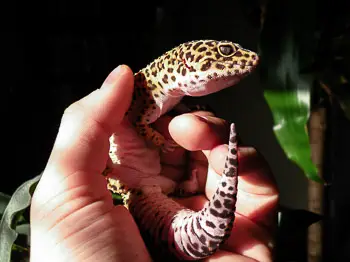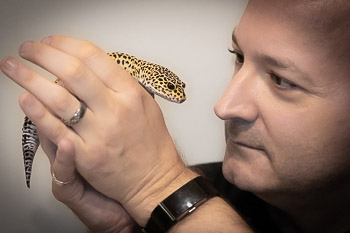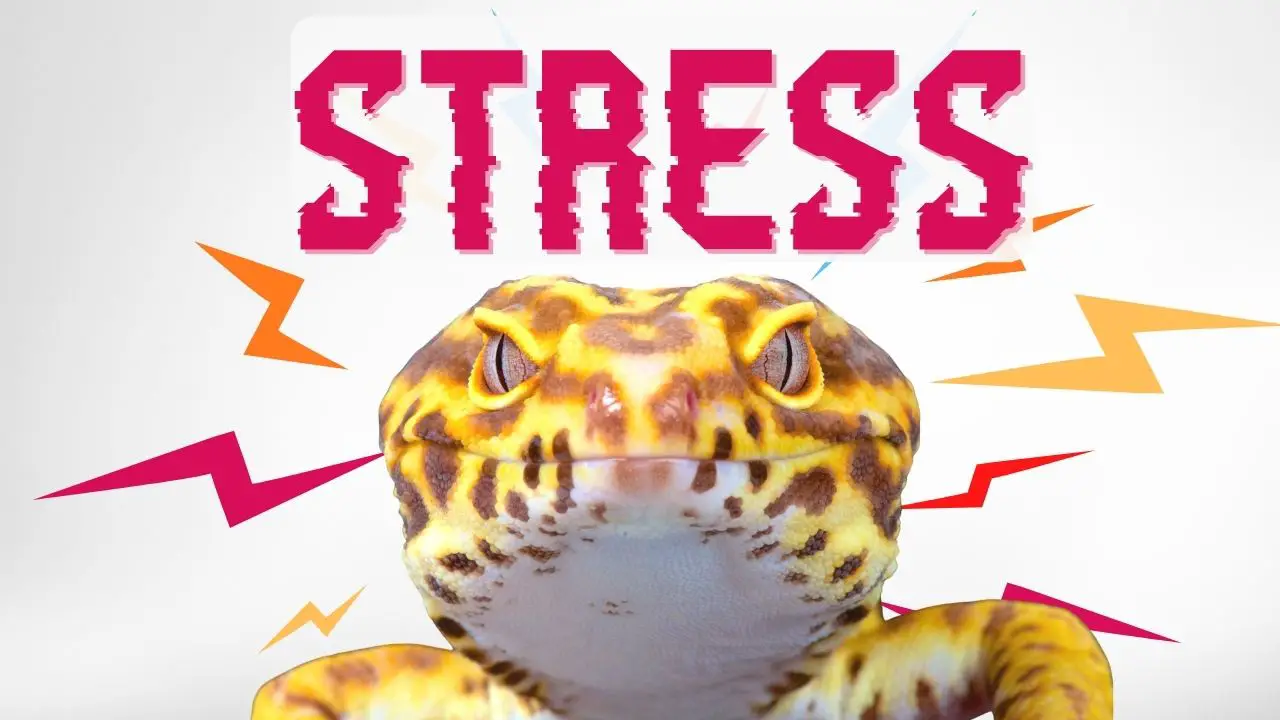Leopard geckos have impressive tails, which serve several vital purposes. Much of the leopard gecko’s body language can be seen in its tail. From a warning, sign of aggression, show of excitement, or a signal it’s going to pounce, you can see it all in the tail.
The tail is a defense mechanism and emergency survival kit, all in one. Read on, some of these may surprise you.
1. Leopard Gecko Tail Waving
You’ll see younger leopard gecko’s tail waving while hunting, and adults will do it sometimes as well. When your leopard gecko stalks its prey, it will raise its tail and wave it slowly back and forth. It will usually give a few quick shakes before launching at its prey.
If your gecko is slowly waving its tail back and forth, almost hypnotically, this is a defensive stance. Consider this fair warning. A leopard gecko may do this in the presence of other geckos, especially between two males. You’ll want to separate these geckos as quickly and cautiously as possible before they attack each other.
Otherwise, your leopard gecko may wave its tail in this manner when spooked or threatened. It’s best to leave it alone. Let it calm down and realize that there is no threat present and it is not in danger. It’s inadvisable to pick them up in this state. Leopard geckos don’t bite often, and this is a sign they are on the defensive and may lash out if provoked.
They’ll calm down and return to their normal temperament if given time to realize there is no real threat.
2. Leopard Gecko Tail Rattling
Geckos will sometimes rattle their tails quickly, much like a rattlesnake’s warning. When a leopard gecko rattles the tip of its tail, this is more of a sign of excitement.
Leopard geckos will often rattle their tail as a kind of mating ritual.
3. Self Amputation
Let’s face it, the leopard gecko is not at the top of the food chain. It’s a small lizard and cannot fend off most predators by force. Leopard geckos are prey for many animals, so they have developed other defense mechanisms. Most notably, they can voluntarily detach, or self amputate, their tails. This sounds kind of gross but it can be a lifesaving, if not traumatic, choice with a high cost.
The ability for a gecko to drop its tail is called autonomy. There are spaces between the bones in the gecko’s tail, which coincide with a divide between two muscle segments. By deciding to voluntarily contract these muscles… POP! Off with the tail!
You’d think an amputated tail would be gory, but blood loss is minimal. There are other muscles that will contract to close off the blood vessels and control the bleeding.
The detached tail will continue to wriggle and flop around after it is dropped. The twitching tail creates a distraction and allows the gecko an opportunity to escape while the predator is focused on the tail.
Alive with no tail is better than ending up as another animal’s lunch.
A leopard gecko will often return to the location where it dropped its tail. Should it find the detached tail, the leopard gecko may eat it to regain some of the fat stores. Losing the tail is stressful, and it removes the safety net of having a backup food supply. Eating the dropped tail provides some much needed energy the leopard gecko will need to grow back its tail.
If you want to see what a detached tail looks like, play the video below. It may not be for the squeamish, but reiterates how a stressed gecko may react by dropping its tail.
Black night geckos are rather rare and expensive morphs, so this is especially sad.
4. Leopard Gecko Tail Regeneration
Should a leopard gecko lose its tail, it will regrow it over the course of several months or so. Though these creatures have the ability to regrow their tails, the new tail is never quite the same as the original. Regrown tails often look stubby, stumpy, or bulbous.
This is a one time trick; the bone within the tail will not grow back, and the gecko will not be able to drop its tail again.
Here is a great photo time lapse of a leopard gecko tail regenerating over a period of about two months. You can see the wound heal and the new tail grow over time.
5. Fat Store
Ever wonder why leopard geckos have such fat tails? The leopard gecko tail is literally fat storage which serves as an energy reserve they can live off of if there is not an available food supply. This is much like another desert dwelling creature, the camel, storing fat in its hump for survival.

When a leopard gecko drops its tail, it loses its fat store and is a source of emergency nutrition.
How long can a leopard gecko live without food, using the fat stored in its tail?
A healthy adult gecko could potentially live a month or more without a meal, using up the fat end energy stored in its tail. Please don’t think this is an excuse to starve your animal or not offer it food. This is a survival mechanism for wild geckos when food supplies and sources are scarce.
Leopard Geckos have been known to get loose and turn up somewhere in the house weeks later with a bit leaner tail, but otherwise a little worse for the wear.
A depleted fat store is usually a temporary condition. With regular feeding, the leopard gecko’s tail will return to a normal healthy width as it regains its fat store.




